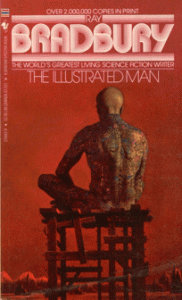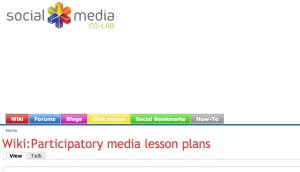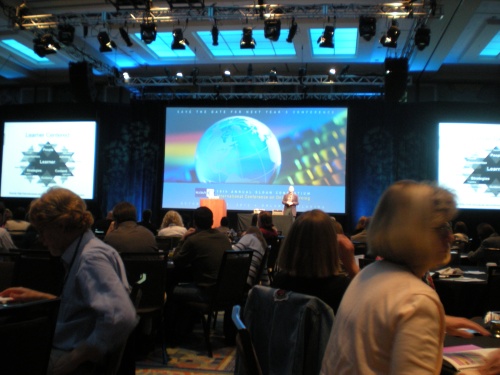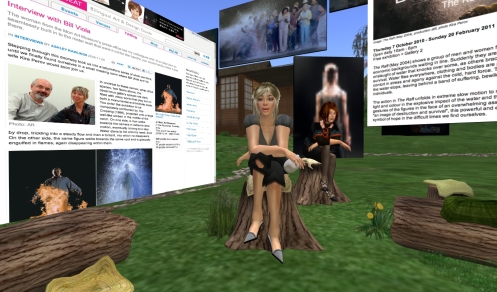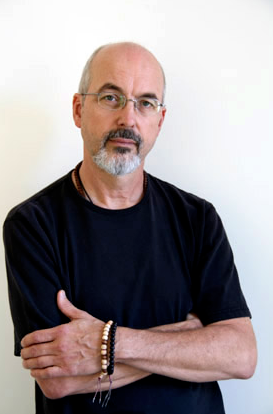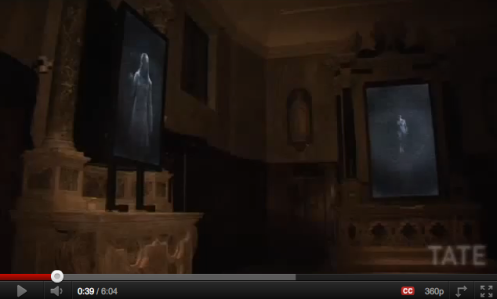This is a test of Hootsuite on my WordPress account.
Thx @Bauman1967 for participants pic at Institute of Medicine’s Gaming Arcade #IHPEGF http://t.co/9rLdEILnPV nice group of world changers
Congrats to @BrushUpGame for Institute of Medicine award http://t.co/Kk6THdkYgO So nice to be there to meet http://ow.ly/MkfKR #IHPEGF
When Ray Bradbury created William Philippus Phelps (the Illustrated Man) he must have had in mind the terrible price one would have to pay for being able to foresee the future. In order to stay with the circus William had an old woman tattoo artist cover him with illustrations. To his horror each of the tattoos would come alive and predict the future. Ironically in Bradbury’s story the old artist had her eyes sewn shut thus was blind but still had predictive powers. To his continual dismay William had to live with the isolation that comes from being able to see peoples’ fates.
In Mary Shelly’s short story the Mortal Immortal the protagonist drinks an elixir that appears to extend his life forever but he can never be sure that he is indeed immortal. He seems to live in the same kind of twilight zone in which William has to exist. In both stories what appears to be a gift is in reality a curse. In a great episode of the X-Files the only thing that Peter Boyle could predict for people was how they would die. Imagine his reception.
To some degree it seems to me that Vannevar Bush, J. C. R Licklider, Doug Engelbart, Ted Nelson, Alan Kay, Adele Goldberg, Marshall McLuhan, Bill Viola and all the others, each in articulating their vision of the future, had to pay quite a price for their gifts. They unhinged society as it was known. What isolation did they suffer? Were they run out of town regularly like William? BTW the tattoo on his back predicted his own death from which he had to continually run. I think visionaries experience a substantial opportunity cost for their ability to see the adjacent possible. The advantage for our friends in the NMR was that their predictions played out slowly and systematically. They could self correct. We have no such advantage. If somebody doesn’t like this post I will know immediately. Things are moving fast indeed.
I think these visionaries were daunted by a Polish proverb
Wszystjie sare czasy sa dobre; All old times are good
Chuck Dziuban (Papuga)
Cross-posting from MixedRealities
Welcome to another episode in which I post about my strange journey through the Wonderland of online courses. Last week I had a most wonderful session of the Digital Awakening course in Second Life: we discussed professor Sherry Turkle’s fascinating text Video Games and
Computer Holding Power, and we also had Howard Rheingold (from the Toward a Literacy of Cooperation course) visiting us. For a great overview of what Howard is up to these days, have a look at the Meeting Howard Rheingold post on the course blog.
I kept thinking about the notion “holding power of the computer”. Watching people staring at the screens of smartphones, tablets and laptops I realized the importance of that idea. What should we think about it? Is it bad, like an addiction?
Compared to the holding power of the television screen it seems to be better as there is interactivity and user generated content – even though not every creation is another Wikipedia.
What about our perception of reality? Is the world of the computer richer or poorer compared to physical reality? One of those interviewed by Turkle prefers his world of games, considering it richer. These are worlds governed by rules which we can, in principle, discover and exploit.
The rules of the non-game world are more intractable and sometimes mysteriously suspended. People lose or fail in the “real world” and they feel cheated, while the computer program just follows its rules and sequences. So is this gaming universe the new ’opium for the people’? Professor Edward Castronova would disagree as he reads characteristics of virtual and game environments as a kind of revolutionary program and the environments itself as a New World where settlers start a new society: read his book Exodus to the Virtual World: How Online Fun Is Changing Reality. Another story about settlers and starting all over again, seems appropriate for Thanksgiving.
But while games are here with us to stay, the debate seems to belong to another era. The big shift in games did not lead to massive mainstream adoption of sophisticated graphical environments, but to social and casual games.
The big dream of a 3D internet in which the 2D web would just be a less exciting part, appears to be – at least for now – just that: a dream.
It’s interesting to see what Philip Rosedale, the founding father and chief visionary of Second Life, is up to these days. He’s all about coworking spaces and virtual currencies which are being used in the ’real world’ to facilitate exchanges in resilient networks (which does not mean he declares Second Life dead and buried).
’Resilient’ and ’durable’, local while staying connected to global networks is the new rallying cry now. A lot of the user-generated creation ethos is making the transition from isolated virtual spaces to connected virtual spaces (using standardized technology which can be used in many environments), to mixed reality spaces (augmented reality) and plain good old reality (co-working spaces) even though using all the affordances of the net and eventually mobilizing the knowledge acquired while running virtual worlds (management of virtual currencies).
On Queen Street Commons I read this from Robpatrob:
Back in 1800, 80% of people in America worked for themselves. The rise in industrialization created the Job as the new normal. By 1980, the apogee of the Industrial model, 80% of us had jobs. But look now at what has happened in only 40 years. 40% of us now work for ourselves.
The Industrial Revolution made work and life in factories, big offices and institutions the new normal. Our education system became more efficient in preparing youngsters for those environments.
Even though our Western societies were advocating the free market, for most workers and students their daily life was governed by that other major steering system: the bureaucracy.
Evangelists of the network economy now see a new “new normal’: back to the micro-projects and -companies, but this time as parts of networks and using aggregation platforms.
There are three pillars mow: markets, bureaucracy and cooperation. This is not detrimental for the market, quite the contrary. If it pushes back something, it’s bureaucracy. Companies rely more on markets for stuff they used to organize internally by bureaucratic procedures.
At the same time more market makes it harder to accumulate capital: the network economy exerts relentless pressure on profit margins (if any). On the other hand, the cost of living could diminish also as people share rather than wastefully underuse computing capacity, transportation, certain household appliances.
People define new Commons and rediscover & modernize old design principles for governing those Commons. Life seems to become more interesting instead of less so: compare a holiday in another country in some fake resort to participating in a ’share the couch’ network.
Or compare indebting yourself for getting a degree from one of the leading education factories to organizing peer2peer learning, deciding your own objectives. Have a look at this TEDxBrisbane video featuring Edward Harran talking about the “knowmad” movement, “an emerging generation that has the capacity to work, learn, move, and play – with anybody, anytime, and anywhere”:
I must admit I feel sometimes like a “knowmad”, traveling from one course session in Blackboard Collaborate to another in Second Life, while exchanging ideas on The Well or in Howard Rheingold’s social media classroom. My fellow-travelers come from North-America, Latin America, Europe, Asia and Australia (unfortunately, there are few or no fellow travelers from Africa). My esteemed US co-learners are about to start the Thanksgiving festivities, which inspire me to think about our journey.
There is this so often used word to describe what I feel about my learning and exploration experiences, a word which sounds very American to me: “awesome”. It’s the feeling of awesomeness I recognize in Harran’s talk, which I share and understand. But at the same time I’m also worried. Knowing how to use online media to organize your own learning together with others is much easier when you already had a decent education – and I’m afraid getting such an education is getting harder, not easier.
Those who lack the talents and skills to become an individual entrepreneur are at risk. As the economist Raghuram Rajan says in his article The Undeserving One Percent?, we use to speak about the one percent and the wealth they accumulated. But we could also look at the top ten percent and about how differences in education and opportunities split the middle class into a upwardly mobile, innovation-minded group and a group which gets poorer and is at risk of being left behind.
Who will help them? Are we sure we’ll have an infrastructure for helping those who have great difficulties in gaining access to the education system, those who are needy, or will the networked society leave gaping holes in which the elderly, the digital illiterates, the socially disadvantaged and the sick will conveniently disappear, out of sight for the young creatives? Will taking care for the poor become once again a feel good-activity for the rich?
There is a challenge here. We should not retreat completely in our networked micro-companies, in our resilient durable local communities. There remains the challenge of scaling up and influence big corporations, the schools and universities, big government, the international institutions because they remain relevant and important. Toppling dictators and challenging university chancellors is not easy, but we do know people can do it. The next phase should be going beyond our local or theme-based networks and contribute to solutions on a macro-level.
How could a day start any better than listening to a Howard Rheingold talk? I ask ya. And here’s how he began…
Learning should be…
– learner-centered
– social and peer-to-peer
– networked
 Rheingold explained that, at the beginning of his teaching career, he was influenced by Neil Postman’s book Teaching as a Subversive Activity – “the questions that students ask are more important than the answers they give.” This doesn’t mean you abandon the texts, but you start with questions, and you make it collaborative.
Rheingold explained that, at the beginning of his teaching career, he was influenced by Neil Postman’s book Teaching as a Subversive Activity – “the questions that students ask are more important than the answers they give.” This doesn’t mean you abandon the texts, but you start with questions, and you make it collaborative.
Howard wrote an article in a 1987 issue of The Well entitled “Virtual Communities” – and thus the term was coined. The article grew into a book, by the same name. In 1995, he was asked by the NEC corporation to help them envision a university of the future. He showed us images of mock-ups he created, with the help of a graphic artist, that looked surprisingly like the profiles that people create in Facebook and MySpace.
In his teaching, Howard emphasizes social learning. As he puts it, students are going to live and work socially and yet the methods and the literature of social learning are not being used.
Here is Howard’s social media classroom platform (built with funding from HASTAC) which he uses to amplify the social environment for his students. The hub includes wikis, blogs, and forums (see the colored tabs at the top in the screenshot above). He’s added lesson plans for educators to help them integrate the technology into the learning – those are available in the wiki portion. With this platform he and his students can index and search through different discussion threads (advantage over Facebook). His goal is to develop the group voice of his class (through forums), along with the individual voice of the student (with blogs).
He describes his approach to his courses as “co-teaching” – students do projects, present to peers, and collaboratively author. There’s no canon to his course, but he does want to give his students background/support research and a vocabulary with which to effectively discuss media together. To help with this, there is a “lexicon” wiki on his social media site where the students in the course work collaboratively to define the terms used in the course. In class time, Howard projects the history page and they work on the lexicon together.
Howard explains that he always has the students in his course sit in a circle…
“There are no back rows in a circle”
The co-teaching teams within the course also make mind maps on the topics they present to each other. This enables them to see the subject matter in a non-linear and networked way. His syllabus is posted on the wiki and offered up as a prezi and a concept map – he requires students to read the syllabus in its entirety, but they can look at it in a number of ways. By doing so, he signals that it’s important to be able to look at material through different lenses.
In addition to his face-to-face teaching, Rheingold is now experimenting with online learning. He’s recently formed RheingoldU (he charges $300 for a 5-week session). His first course: Introduction to Mind Amplifiers. He calls the students here “co-learners” – he defines the borders of the learning, but they decide from there how and where to go. Each student has a blog and they use the course wiki, along with live sessions and streamed video. He encourages the participants to do a group mind-map in the white board on the webinar platform (I’ve seen Nancy White do this as well to great effect). One of the interesting things about that exercise is that you don’t know who’s adding what – it’s a bit of magic, showing them how they can act as a collective intelligence. What Howard terms, “Peerogogy” (you heard it here, folks, a new, catchy Rheingold-term!)
Howard has created mini-courses – learning objects on a given topic that are served up online. Each of the mini-courses has a short video (10-15 minutes) of Howard talking, along with other resources, Delicious links (available with tabs). Here’s a sample: A mini-course on network and social network literacy. As Howard puts it, “we have the tools available to us to “roll our own” – for free!”
He says he’s been amazed at his students’ limited social literacy. They don’t understand the rhetoric of a wiki, how you can use a forum for group discussion, how to use a blog to reflect and clarify your thinking. He sees this as a critical education priority going forward.
Howard has been working with his students on something that he calls “Infotention” (yup! there’s another one!) – developing your attention skills, training your attention span, and learning how to use IT skills (RSS feeds, persistent news search, and dashboards) to support your attention. As Howard put it, it’s critical to use the information that’s flowing into you in a way that allows you to make faster and better decisions. Asking yourself, for example…Ignore or attend? Open a tab for later? What are the right spatial arrangements (highest priority on the left, most frequently updated is on the top). He tries to help his students match their attention to the tool set, to start small and cultivate habits. He also cautions that there are days we must recognize that we need to get something specific done and therefore must be mindful of how your attention is spent. Set a goal and then regularly, through the day, ask yourself, is what I am doing now bringing me closer to my goal for the day?
He described an interesting (very low tech) activity he does with his students using yellow, orange and red post-it notes. A gong goes off at irregular intervals and, at that point, students write down what they were thinking about on the appropriate colored post-it notes. Yellow if the thought was on task, orange if it tangential to the task at hand, and red if it was off task. The post-its get assembled in a common spot on the board (this could be done online as well) so that the entire class can track its collective “infotention”.
He talked about the importance of critical consumption (what Ernest Hemingway called “crap detection”). He used the classic Martin Luther King example – search on “Martin Luther King”, note the third entry down. Go to Easywhois to find out who owns the domain and you discover that the page is owned by a white supremacist organization. Other examples like this: Free Online Pregnancy Test – enter your name, sit still while we scan you. Genetics First. Pacific Northwest Tree Octopus. He’s got a million of them.
Howard’s wrap up: Our future depends upon participation, collaboration, and network awareness. He has a new book coming out called Net Smart (published by MIT Press) which he decided to write because, with all of the marvels of the online world, there is still a lot of crap out there. We can’t really regulate this (nor would we want to), but we can improve and increase the number of people who know what they are doing so that we can properly sort through it.
After he concluded his talk, as he packed up his bag, I made my way to the front to introduce myself. While I am a long-time Rheingold fan, I had a further purpose – he has accepted an invitation to join our New Media Faculty Seminar (which meets in Second Life) in two weeks. He was gracious and warm, shook my hand, and said he was looking forward to joining us in world. Class act.
Cross-posting from MixedRealities
Applying Aristotle on interactions between humans and computers: it can be done. Just read Brenda Laurel about The Six Elements and the Causal Relations between them (in the New Media Reader, MIT, links and documents here) as we did in the Digital Awakening course.
Aristotle talks about drama as an organic whole. He distinguishes six qualitative elements: action, character, thought, language, pattern and enactment.
I’d like to pick out just one nugget out of this text: how we’re humanizing our tools. Once computers were being considered as big, clunky, intimidating and often maddening machines, a kind of dumb administrators.
Visionaries such as Vannevar Bush, J.C.R. Licklider, Doug Engelbart and Ted Nelson saw very early on that computers could be much more.
It’s not just that the entertainment and social aspects of computers (in all their forms) prove to be so appealing. It’s that something in our relation with those devices is changing dramatically.
In her discussion of the element ’Thought’ Laurel mentions the familiar conundrum:’can computers think’ and the answer is surprisingly easy: ’computer-based agents, like dramatic characters, do not have to think (in fact, there are many ways in which they cannot); they simply have to provide a representation from which thought may be inferred.’
When you double-click on a folder of your Mac and it divulges its content, it seems as if it understood what you wanted. Does it actually understand anything at all? It does not matter; “The real issue is that the representation succeeded in getting me to make the right inferences about it’s “thoughts”. It also succeeded in representing to me that it made the right inferences about mine!”
This idea of making inferences about the “thoughts” of devices spreads of course as our computers become slick, small, nigh-powered devices we carry all the time with us. Increasingly, we’re no longer limited to double-clicking folders, but we can speak to those devices – humanizing them even more.
This may seem self-evident, bit it’s obvious this is a vast project and we’re just in the initial phases. Just think about how we deal with news media. Instead of searching desperately in unwieldy online newspaper archives, your smartphone – as your personal assistant – will alert you when there’s breaking news about, let’s say, Occupy Wall Street (OWS).
You’ll enter into a conversation, you’ll ask a question to get more details, a background question about someone who is mentioned in the report. Your personal assistant will use lot’s of sources, narrating the answers to your questions, indicating sources or taking into account the reputations stats of the sources. Chances are it will not be some mainstream media company developing such an assistant, but yet another young tech company.
The GigaOM Roadmap conference discussed this kind of evolution. Om Malik reports on GigaOm:
Mathew Ingram. The thread I was most interested in that came out of RoadMap was what Jack Dorsey called “the arc where technology meets humanness.” The Twitter and Square founder talked about using technology to help us connect more with what makes us human, Tony Fadell of Nest talked about making devices that respond more intuitively, and Mark Rolston from frog design was really passionate about getting the computer out of the way, to the point where we barely even realize there is a computer at all. Put together, all those make for a very powerful message that I wish more technology companies would pay attention to.
In Natural Born Cyborgs? by Andy Clark the author says:
Understanding what is distinctive about human reason thus involves understanding the complementary contributions of both biology and (broadly speaking) technology, as well as the dense, reciprocal patterns of causal and co-evolutionary influence that run between them. We cannot see ourselves aright until we see ourselves as nature’s very own cyborgs: cognitive hybrids who repeatedly occupy regions of design space radically different from those of our biological forbears. The hard task, of course, is now to transform all this from (mere) impressionistic sketch into a balanced scientific account of the extended mind.
So the computer becoming human-like is not something external, which happens “out there” and involves just one of the many tools we humans use. It actually is another evolution of our extended mind, our becoming increasingly cyborg-like.
It also has implications for our perceived identity. This could be an aspect of this remark in Clark’s above mentioned text:
In addition it may soon be quite important (morally, socially, and politically) to publicly loosen the bonds between the very ideas of minds and persons and the image of the bounds, properties, locations and limitations of the basic biological organism.
The nice thing for my course-program this Fall is that these texts and discussion allow me to “connect the dots”: Clark and his thinking about the extended mind is an important part of a previous course facilitated by Howard Rheingold (Introduction to Mind Amplifiers) which is not unrelated to his other courseToward a Literacy of Cooperation, while the discussion about Brenda Laurel and the Six Elements is part of the above mentioned Digital Awakening course. Next Wednesday we’ll meet Howard in that course (in Second Life), and we’ll discuss Sherry Turkle’s text Video Games and Computer Holding Power (documents, program and practical details can be found here). One of the aspects of Turkle’s research is about role-playing and the exploration of “aspects of the self” and seems to fit very nicely in the context of the previous discussions.
In my “scientific” journey for a more sharp focus for my research en-devour, I try to be “open” for connections, for the emerging creative inquiry process. The art is now, how to define the edge (boundaries) of the circle of focus. I’m pondering on: how to be interdisciplinary in my approach without diminishing argument integrity? Looking for a new balance between “solid foundations” (deductive routine) and what Feyerabend coins as “scientific anarchy” (my interpretation: new inductive chaos). I’m being pulled back and forth between the overwhelming new opportunities of new media (in this case: the possibility of abundant user-generated data) and the” back to basics” research questions. Tomorrow I will only try inductive reasoning and see where that takes me. It feels as if I have an answer, but I still don’t know what my question was in the first place. Inductive is more intuitive, it embraces complexities, it just feels right, but it is an overwhelming ride.
A quote I came across this week, when reading Bill Viola‘s essay “Will there be Condominiums” in Data Space?” for #nmfs_f11 keeps echoing in my mind:
Scientists always marvel at nature, at how it seems to be some grand code, with a built-in sense of purpose. Discoveries are made which reveal that more and more things are related, connected. Everything appears to be aware of itself and everything else, all fitting into an interlocking whole.” (Bill Viola, 1982)
I will for now answer Bill Viola’s question he posed in 1982; “Will there be Condominiums in data space?” with a No. Condominiums are fragmented, as he himself knew more than anyone else. I feel more for an ocean of data, where fluidity represents connectedness. But the challenge with the more natural “everything is connected” approach is the question: from which angle do I have to look at this perpetual continuity, and what is enough for this project of mine? Or is “the ocean [indeed] without a shore” as the title goes of one of Viola’s art-projects?
Bill Viola’s “Raft” fits the feeling described here perfectly:
Questions, focus…please, do emerge soon…
Tonight’s Bill Viola NMFS discussion was enhanced by a special guest visitor to our Second Life group this evening. Ariella Furman, who is a machinima artist, joined us and added her valuable insight to the seminar. The session was enhanced by multiple poster boards and media screens, compliments of Chimera, displaying web pages, video clips, and images relating to Viola’s work and life. It was a rich conversation about data spaces, art, single event captures (versus multiple perspectives), exploration, perspective, education… whew!
I just finished this week’s reading – Bill Viola’s Will There Be Condominiums in Data Space? I’m embarrassed to admit that, previous to this reading, I’d never heard of Bill Viola. Viola is a contemporary video artist, still living, who is apparently responsible for bringing video into the mainstream of contemporary art. His work has been exhibited all over the world and deals with the central themes of human consciousness – birth, death, relationships, emotions.
The reading sent me to Google so that I could see some of Viola’s work (worth a wander – lots of fascinating stuff). Here’s one of my favorites: Ocean without a Shore. It’s a video detailing an installation that Viola created in a chapel in Venice with video screens mounted on alters, depicting human forms emerging from water. Lovely, lovely.
Viola’s essay did a wonderful job of putting film and video into the context of memory and the way our brains work. He must also be a student of history as his work and his writing are so richly informed by studies of ancient texts and art forms. I loved his reflections on video as an idea space and a memory system. He refers to the Greeks walk-through memory temples (interesting aside to Joshua Foer’s NT Times magazine essay on Memory Palaces). I particularly appreciated his explorations of the connections between ancient and modern technologies… the Indian tantric doctrine of three traditional expressions of the deity – the visual depiction, the yantra (energy diagram), and the mantra (chanting). He uses these as a basis to explore the different ways we could travel through data structures and data spaces – for instance, branching video (very cool pedagogical idea).
Much of his work seems to revolve around water. Oceans, sprinklers, reflecting pools, water droplets. Interesting. Our most fundamental molecule. Water….drinking, sustenance, cleansing, dissolving, solvent, rinsing, baptism, drowning, equilibrium, surface tension.
But what of the title of his essay? Condominiums in Data Space. My take on it is that Viola is saying that there might be greater exploration, more opportunity in data space that is not broken up into condominiums. That there is more room for unusual approaches, non-traditional perspectives, and unexpected conclusions with flexible data spaces. What do you think?
He ends the essay with a most un-McLuhan-esque thought:
Applications of tools are only reflections of the users – chopsticks may be a simple eating utensil or a weapon, depending on who uses them.
That one caught me short. But then, at the very end of the essay, he tells this funny story, The Porcupine and the Car. A little fable, a cautionary tale, that I’m not sure how to interpret. The foolish, puffed up attitude of the porcupine? The overpowering hubris of technology (the car)? The Rashomon nature of our existence? A very strange coda.
